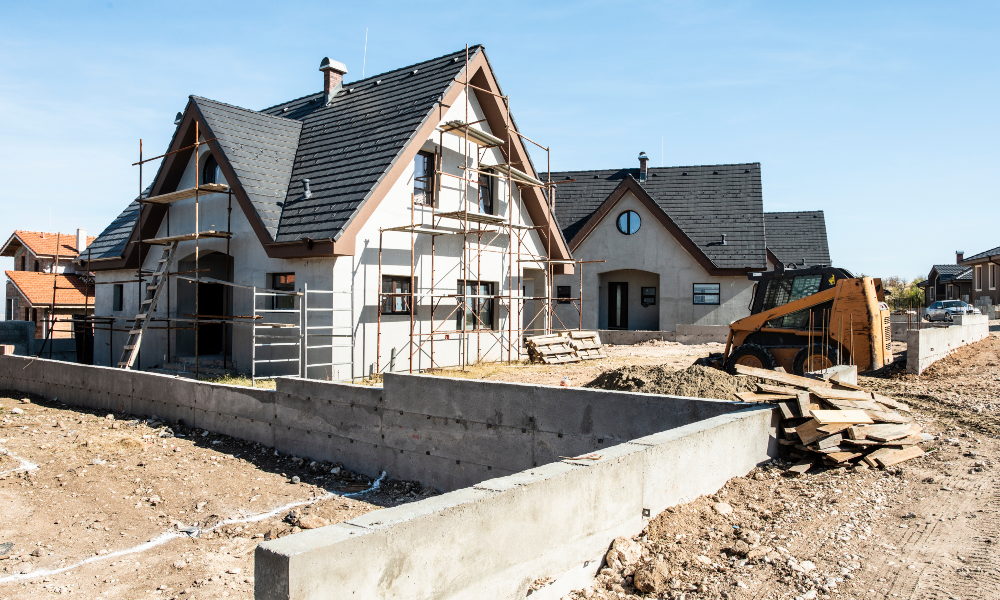New construction data from March shows a sharp turnaround from February’s brief spike in production. Interest rates and elevated labor and materials costs continue to hammer housing production, it seems, as builder confidence remains firmly in the negative and outlooks for the broader housing market slip into declines.
March’s New Residential Construction Numbers Seem to Give Up February Gains
Overall housing starts decreased 11.4% compared to February, dropping down to a seasonally adjusted annual rate of 1.32 million units in March, according to a report put out by the U.S. Department of Housing and Urban Development and the U.S. Census Bureau. This is the number of units builders would begin if development kept the current pace for the next 12 months. This is, however, still up 1.9% from March 2024 numbers.
Within that broader statistic, single-family housing starts were down 14.2% to a seasonally adjusted annual rate of 940,000 compared to February’s numbers, and down 9.7% from a year prior.
Meanwhile, the multifamily sector, which consists of apartments and condos, decreased 3.5% to an annualized 384,000 rate.
Midwest Sees Largest New Construction Surge in March
Breaking these segments down by region, the Midwest saw the biggest construction surge in March, with new housing starts up 76.2% from February’s numbers. The Northeast saw a meager 1.4% increase from the prior month, while both the South and West markets saw sharp drops in production. The south saw a 17.1% drop from February, while Western housing production fell 30.9%.
Affordability Woes Continue to Worsen
In their monthly assessment of new residential construction, the National Association of Homebuilding (NAHB) noted a substantial weakening of demand as elevated mortgage rates and rising construction costs priced even more entry-level buyers out of the market in March.
“The drop in March housing starts is a clear signal that affordability pressures are intensifying,” said Buddy Hughes, chairman of the National Association of Home Builders (NAHB) and a home builder and developer from Lexington, N.C.
Prices of raw materials used in housing construction remained elevated with many, such as lumber, steel and aluminum expected to rise even further unless current tariffs are altered. Meanwhile, the expectations of lower regulatory pressures seen at the start of the newest presidential administration, have yet to be addressed.
In the National Association of Home Builders (NAHB)/Wells Fargo Housing Market Index (HMI), the NAHB asked its members how much they have already seen prices increase among manufacturers. Sixty percent (60%) of builders reported their suppliers have already increased or announced increases of material prices due to tariffs. On average, those price increases came out to 6.3%, meaning the typical cost effect of recent tariff sits at $10,900 per home.
NAHB’s assistant vice president for forecasting and analysis, Danushka Nanayakkara-Skillington, states that unless there is targeted policy support, addressing the affordability crisis will remain an uphill battle.
Shifting Market Conditions See Former Bull Turn Bear
At the start of the year, housing search giant Zillow saw national home prices rising a solid 2.9% over the course of 2025. However, in their March monthly update, those expectations have now dropped into bear territory, with Zillow predicting that instead, housing prices will fall 1.7% between March 2025 and March 2026.
Zillow economists cited a rise in active listings throughout March being the main culprit in their assessment, seeing a shift towards buyers in terms of negotiating power. However, despite the shifting power dynamic, many potential buyers are opting to rent instead as the affordability issues suppress demand.
Home sales across the U.S. dropped 5.9% last month to a seasonally adjusted annual rate of 4.02 million, according to the National Association of Realtors (NAR), U.S. News reports, while economists polled by Reuters had forecast home resales declining to a rate of 4.13 million units. The inventory of existing homes jumped 8.1% to 1.33 million units in March while supply ticked up 19.8% year-over-year. The median existing home price increased 2.7% from a year earlier to $403,700 in March.
Throughout the nation, however, no region is expected to be hit harder by this housing “correction” than the Sun Belt, a location that houses its own lion’s share of integrators. According to Zillow, a weakening market across this area of the United States is expected to weigh the most on nationally aggregated housing prices this year.
Builders Feel Little Confidence Amidst Policy Confusion
Overall permits, which can be loosely viewed as an indication of perceived demand in the coming months, rose a modest 1.6% compared to February to an annualized rate of 1.48 million. Among those numbers, however, single-family permits dropped 2% to 978,000 while multifamily permits rose 9.3% to a 504,000 rate.
On a regional basis, permits were 24.7% lower in the Northeast and 8.8% lower in the West. Southern and Midwestern markets saw increases at 0.4% and 4.7% respectively.
Builder confidence, meanwhile, remains firmly in the negative, despite a minor bump in confidence due to retreating mortgage costs earlier in the month. The HMI saw builder confidence in new single-family construction sitting at 40 in April, up a point from March.
For reference, any number over 50 for the HMI indicates more builders view conditions as good vs. poor.
The HMI index charting sales conditions rose two points to 45 in April while the gauge charting prospective buyer traffic rose a single point to 25. Meanwhile, sales expectations for the next six months dropped four points to 43.
Keep Reading:
See what experts are saying about tariff impacts in CI
Read up on how much value smart technology actually adds to a home
Or peep how SAV is engaging the homebuilding industry with its “Quality Cuts” event

















